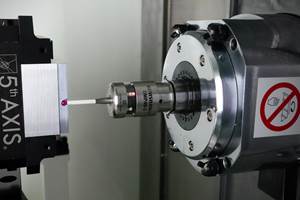Scanning CMM Technology Made More Affordable
While scanning CMMs have been around awhile, they haven't become a mainstay of general production mainly due to cost. There's little question as to the value that scanning can provide. Conventional CMM workpiece measuring processes are limited by the number of points that can be collected and analyzed in a reasonably time-efficient manner. Thus, point-by-point inspection in essence provides a spot check confirmation of certain workpiece features, but it can easily miss a variety of nonconforming geometry in between those checkpoints.
While scanning CMMs have been around awhile, they haven't become a mainstay of general production mainly due to cost. There's little question as to the value that scanning can provide. Conventional CMM workpiece measuring processes are limited by the number of points that can be collected and analyzed in a reasonably time-efficient manner. Thus, point-by-point inspection in essence provides a spot check confirmation of certain workpiece features, but it can easily miss a variety of nonconforming geometry in between those checkpoints. For instance, taking just three points on a circle is a reasonably reliable check that the feature is in fact on center, but it tells very little about the true roundness of a hole. Indeed, the very same data could be derived from measuring the midpoints of an equilateral triangle.
With scanning, however, thousands of points can be taken where it was previously practical only to take a few. That allows manufacturers to check both dimensional conformity and geometry at once, providing a much more complete picture of the true quality level of a machining process without sacrificing measurement speed. Moreover, in reverse engineering applications, a more complete and accurate description of the original artifact can be obtained from the start.
The problem is, scanning CMMs historically have been expensive, which has precluded them from achieving a broad role in manufacturing applications. Carl Zeiss IMT Corp. (Minneapolis, Minnesota) hopes to change all that, however, with the introduction of its new Contura scanning CMM. It is a product, says the company, aimed at the "mid-range market" where touch-trigger CMMs have historically reigned.
The builder says the CMM is an affordable system offering both high accuracy and flexibility. It is suitable for a wide range of applications including inspection of castings, plastics, brake components, Styrofoam, medical implants and instruments, wheels, dies and molds, and a range of job shop applications.
The CMM comes with a new "VASTXT" probe head, based on technology first introduced in 1995. This enables the CMM to inspect a wider range of feature tolerances—including form, size and location—than practical with traditional probing technology. Measuring productivity is improved by eliminating multiple workpiece setups or the need to transport parts between different measuring machines. It also adds reliability to the measuring process by providing a high degree of data density. The machine is guaranteed to provide form measurements to a precision of 3.4 microns.
As for versatility, the machine can be operated in a number of modes. Fast single point measurements can be taken for simple tasks and to provide probing compatibility with other machines where a touch trigger probe head is required. Or, form elements can be scanned for all prismatic workpieces featuring circles, cones and planes. Speed and evaluation are preset as a function of the measuring task.
Known contours can be scanned for curves and free-form surfaces. Or unknown contours can be scanned with data-density-controlled speed settings—a mode that would be used to digitize free-form surfaces. Also, "self-centering" scanning can be used to guide the probe head in grooves, slots and other captured features.
The Contura CMM offers a measuring range of 28 by 40 by 24 inches, with accuracy stated as "u1=2.2 + L/300." Probe tip diameters go as small as 0.5 mm. Wraparound air bearings are used in all axes for high speed performance, and ceramic technology is used to enhance temperature stability. Zeiss guarantees its stated measuring certainty from 65° to 71° F.
The CMM is equipped with a 32-bit Pentium II-based "ISC" (Intelligent Scanning Control) controller, the first in a new generation of controls. It is available with two software packages. The UMESS package offers the highest level of functionality, while the Calypso offers CAD-based, Windows NT software. Both can be combined with the Holos software option, designed for measurement of 3D surfaces, and Dimension, a new package designed for reverse engineering tasks.
Related Content
How to Choose the Right Cut Off When Measuring Roughness
Measurement results for surface finishing parameters can vary depending on the filter parameter (Lc), also known as the cutoff.
Read MoreWhat Should Machinists Know About In-Machine Probing?
In-machine probing doesn’t reach the power of CMMs but can still be useful for pre- and mid-process control, as well as for “rough screening” of parts.
Read More4 Ways to Establish Machine Accuracy
Understanding all the things that contribute to a machine’s full potential accuracy will inform what to prioritize when fine-tuning the machine.
Read MoreChoosing the Correct Gage Type for Groove Inspection
Grooves play a critical functional role for seal rings and retainer rings, so good gaging practices are a must.
Read MoreRead Next
3 Mistakes That Cause CNC Programs to Fail
Despite enhancements to manufacturing technology, there are still issues today that can cause programs to fail. These failures can cause lost time, scrapped parts, damaged machines and even injured operators.
Read MoreThe Cut Scene: The Finer Details of Large-Format Machining
Small details and features can have an outsized impact on large parts, such as Barbco’s collapsible utility drill head.
Read More








.png;maxWidth=300;quality=90)


.png;maxWidth=300;quality=90)













